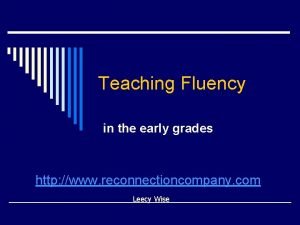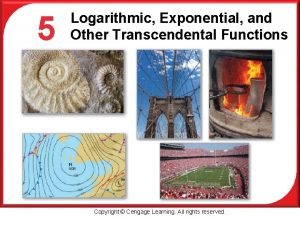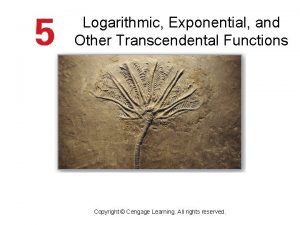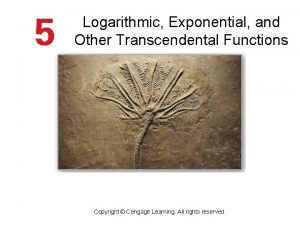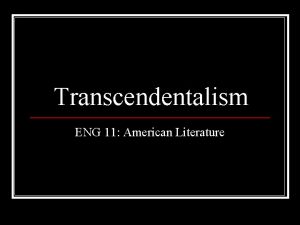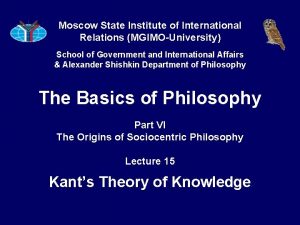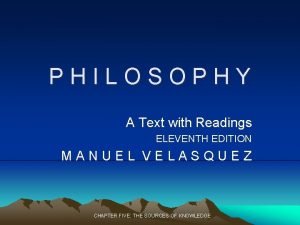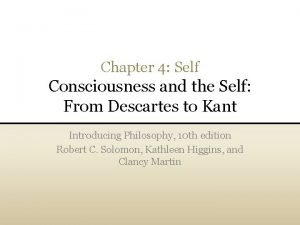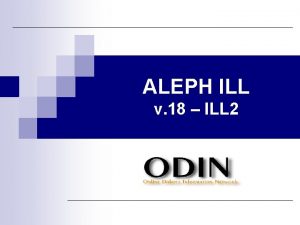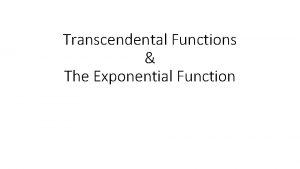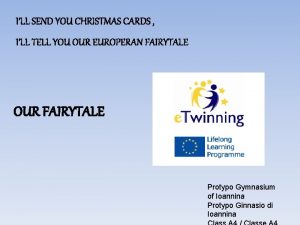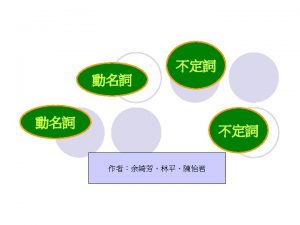The Transcendental Learner Tell me and Ill forget

















- Slides: 17

The Transcendental Learner “Tell me and I'll forget; show me and I may remember; involve me and I'll understand. ” -Chinese Proverb

Overview ➲ This project acts as an exploration of several topics, seeking to argue the importance of introducing an increasingly effective teaching methodology with the incorporation of a musical experience for the purposes of language learning

Language Learning: Basic Theory ➲ Beyond the IPA (International Phonetic Alphabet) teachers can use other techniques to expand on a learners reproductive skills ➲ Students of all levels have an inherent need to actively engage with the material presented; for both young and old learners this can be an extremely involved experience, capitalizing on each of the 7 types of learning, especially auditory learning

The Importance of Listening ➲ According to Snow (1996) in More than a Native Speaker; many language programs devote more attention to speaking rather than to listening ➲ Additionally classroom exercises with listening components often consists of “slow, clear classroom practice” ➲ “A student who is a good listener can generally keep a conversation going by being a good listener and occasionally responding with simple questions, short answers, or even grunts and nods” ➲ Listening exercises encourage students to develop a range of cultural background knowledge that helps them predict what they might hear in order to comprehend a message

Three Examples of Folk Songs: and their cultural context ➲ Ru Con, Lý Đât Giồng, Qua Câ u Gió Bay ➲ Lyrics and Meaning ➲ Popularity: Phô Biến: The popularity of each song connotes a different context

Ru Con 1. Gió mùa thu me ru mà con ngu Na m (o ) canh chày, na m (o ) canh chày, thư c đu vư a na m Hơ i chàng o i, hơ i ngu ơ i o i Em nhơ tơ i chàng, em nhơ tơ i chàng Hãy nín đi con, hãy ngu đi con Con hơ i là con hơ i, con hơ i Con hơ i con hơ i, hơ i con! Southern Folk Song: a nice but sad melody, most famous as a motherly expression of loneliness, or nostalgia at the husband being away as she sings an infant to sleep at night, causes her to think about many things 2. Đê n mùa xuân trong co n mà gió â m Cha (o ) con vê , con nă m tay cha Hơ i nàng o i, hơ i ngu ơ i o i Tôi nhơ tơ i ngu ơ i, tôi nhơ tơ i ngu ơ i Hãy nín đi con, hãy ngu đi con Con hơ i là con hơ i, con hơ i Not many young people know Ru Con, although it was apparently popular in many Việt school districts

Lý Đât Giồng Trên đâ t giô ng mình chơ đơ i ai nghe tiê ng hò mà lòng trọ m thu o ng Hơ i cô gánh nu ơ c bên đàng Còn bao là bao gánh nư a Đê qua là qua gánh dùm tang tình tang tính tình là tình tính tang Trên cách đô ng chi mọ t mình anh Thu o ng vơ i chơ là chơ đơ i ai Khô thân con khi nó ơ lùm Đâ t không mà lo cuô c Lo dòm lo dòm ngu ơ i ta tang tình tang tính tình tang ➲ On the other actually a situation where, despite the maternal sentiments of the song, most mothers don't know how to sing it ➲ Contrasts with Qua Câu Gió Bay in that the mother figure does not (mẹ của em) approve of the situation

Qua Câ u Gió Bay Yêu nhau cơ i áo ô i à trao nhau Vê nhà dô i ră ng cha dô i me a à a á a Ră ng a ô i a à qua câ u, tình tình gió bay Yêu nhau cơ i nón ô i à cho nhau Vê nhà dô i ră ng cha dô i me a à a á a Ră ng a ô i a à qua câ u, tình tình sư t quai Yêu nhau cơ i nhâ n ô i à trao nhau Vê nhà dô i ră ng cha dô i me a à a á a Ră ng a ô i a à qua câ u, tình tình đánh ro i Refers to the independence of two lovers, from the notorious Ho Bác Nính- in North Vietnam - expresses relations between the two young lovers and their ability to express themselves openly Qua Câu Gió Bay was composed as a work song, and is still sung in an ask and answer format by field workers today

SEASSI Vietnamese Methodology for Musical Study 1) Elicits a word by word translation from the students ➲ 2) Elicits a more fluid translation from the students ➲ 3) One teacher then sings through the song one time ➲ 4) Next the teacher sings through the song with students repeating line by line ➲ 5) Finally the students and the teacher sing through the song in its entirety ➲ 6) Emphasis is on introducing the culture more holistically, rather than a specific curriculum ➲

Music as a means of Development: A Study Routine ➲ This material about to be presented is based: ➲ on The Lexical Approach described by Michael Lewis in Implementing the Lexical Approach (1993) ➲ Other pillars of learning acquired through The Communicative Approach ➲ and methods adapted from Don Snow in More than a Native Speaker ➲ Though this project no longer focuses on English Language Instruction, the methodology presented here will be compared to the SEASSI methodology

Lyrically Based Lexical Acquisition ➲ Materials: An authentic audio passage relevant to the students target context: a classic song and lyrics ➲ Assumption: There will be no more than 5 -7 new vocabulary words in the passage. ➲ Primary Staging: 3 Listening Stages and 2 Vocabulary Stages

Lyrically Based Lexical Acquisition ➲ Secondary staging: Pronunciation Vocabulary and Pronunciation Reinforcement Controlled Practice Language Exploration Record Review

Benefits Assessment: Lyrically Based Lexical Approach ➲ The Lyrically Based Lexical Approach ensures that learners are learning new vocabulary from the song and will no doubt memorize it and be able to use it appropriately by the time that they have left the classroom ➲ Expands on all four language skills

LÝ CHIỀU 1. Nghe bài hát và điền vào chỗ trống. LÝ CHIỀU (Dân ca Nam Bộ) Chiều chiều ____ ____ ____ tang tình gánh ____ Tưới ____, tưới ____ Ngô Đồng Xui ____ xui ____ lòng ____ tưới ____ Ngô Đồng. 3 Trả lời các câu hỏi sau đây (Answer the following questions) a. Người con trai (young man) đang ở đâu ? b. Khi đứng ở đó người con trai thấy ai ? c. Người đó gánh nước để làm gì? 2. Tìm từ trong bài có nghĩa tương đương với các từ tiếng Anh sau đây To love : To Stand : In my heart : West : To water : Who/ whom : A Tree : A girl : To see : Afternoon

LÝ CHIỀU 4) Hãy giải thích nghĩa của các cụm từ trong bài và cho ví dụ (Explain the meaning of the phrases in the song and give examples) Chiều chiều. Trong lòng. Tây lầu tây- 5) Nội dung của bài này là gì? (What is the main idea of this folk song)

Benefits Assessment: SEASSI Methodology ➲ First the SEASSI learning method is simply faster, while the Lexical Approach is excellent for a six-month curriculum, it does not suit the needs of teachers and students in four week intensives sessions Placing multiple levels of learners in a single classroom has its benefits ➲ ➲ By ensuring that the students are learning simple tunes, this creates an association between auditory and visual memory in the mind of the students ➲ This can be particularly helpful when studying a tonal language ➲ Furthermore, in the SEASSI methodology we see that the cultural context of the language experience really comes alive

Thank you! Any questions? William Brokaw Noseworthy
 Tell me and ill forget
Tell me and ill forget Remarks on lazy and eager learning
Remarks on lazy and eager learning Scream and ill tell your mom
Scream and ill tell your mom Tell me and i will forget
Tell me and i will forget Show me and i will forget
Show me and i will forget Tell me and i forget
Tell me and i forget Transcendental functions examples with solutions
Transcendental functions examples with solutions Inverse functions
Inverse functions Integration of exponent
Integration of exponent Tell me what you eat and i shall tell you what you are
Tell me what you eat and i shall tell you what you are What is transcendalism
What is transcendalism Rationalist vs empiricist
Rationalist vs empiricist Transcendental aesthetics
Transcendental aesthetics How transcendental are you
How transcendental are you Transcendental phenomenology
Transcendental phenomenology Transcendental movement
Transcendental movement Transcendental idealism
Transcendental idealism Transcendental self
Transcendental self
